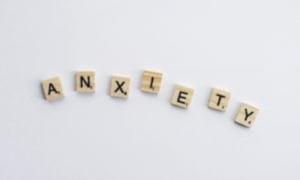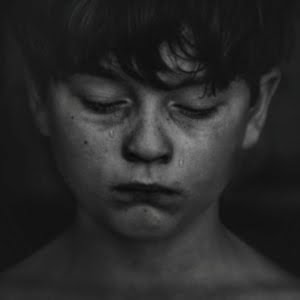Anxiety and worries are a part of everyday life for most individuals, especially with everything going on in the world. Not only do our children see and feed off our anxieties, but there are also many more stressors that children face today. So how do you know if these anxieties/worries are just a phase, or actually anxiety disorders in children?
Anxiety disorders in children can prevent kids from making friends, thriving in school or sports, and experiencing all that life has to offer. Anxiety can be paralyzing and leave children with feelings of shame, fear, and isolation. The good news is that with treatment and support from loved ones, children can successfully navigate and manage anxiety symptoms.
Common Anxiety Disorders in Children
Generalized Anxiety Disorder
 For most children, small amounts of anxiety and stress are part of daily life. However, for less than 1% of children, these worries become overwhelming and excessive. Generalized Anxiety Disorder is characterized by excessive worry about various events or activities. The worry tends to be age-appropriate and for most children involves worries about family problems, peer relationships, health, grades, and/or sports. San Diego Christian Counseling can offer valuable support in these issues.
For most children, small amounts of anxiety and stress are part of daily life. However, for less than 1% of children, these worries become overwhelming and excessive. Generalized Anxiety Disorder is characterized by excessive worry about various events or activities. The worry tends to be age-appropriate and for most children involves worries about family problems, peer relationships, health, grades, and/or sports. San Diego Christian Counseling can offer valuable support in these issues.
The following list includes symptoms a child with Generalized Anxiety Disorder may have:
- Over-conforming
- Perfectionism
- Insecurity
- Sleep disturbance (fatigue or inability to sleep)
- Restlessness
- Difficulty concentrating
- Irritability
Obsessive-Compulsive Disorder (OCD)
Obsessive-Compulsive Disorder, or OCD, involves unwanted and recurrent thoughts (obsessions) that cause anxiety or distress leading to repetitive behaviors or mental acts (compulsions). The average age of onset is 10 years old and involves the child being unable to suppress the thoughts and compulsions on their own.
Some obsessions you may notice in your child include:
- Worry about dirt, germs, or contamination
- Fear of harm or danger to self or others
- Concern about order or symmetry
Some compulsions you may notice in your child include:
- Hand washing to avoid germs
- Ordering objects in a specific way
- Repeating a word, phrase, tune, or prayer
- Counting steps
Panic Disorder
Panic Disorder involves an abrupt surge of intense fear or discomfort that peaks within minutes. Your child will be diagnosed with panic disorder if they have experienced 2 or more panic attacks that come on suddenly and are followed by a month of concern about having another attack. Often, individuals will state these attacks made them feel as if they are “going crazy.” A panic attack will involve at least four of the following symptoms:
 A feeling of imminent danger or doom
A feeling of imminent danger or doom- The need to escape
- Rapid heartbeat
- Sweating
- Trembling
- Shortness of breath
- Feeling of choking
- Chest pain or discomfort
- Nausea or abdominal pain
- Dizziness or lightheadedness
- Sense of things being unreal
- Fear of losing control or “going crazy”
- Fear of dying
- Tingling sensations
- Chills or hot flushes
Post Traumatic Stress Disorder (PTSD)
Trauma is defined as any deeply distressing or disturbing experience. When a child is diagnosed with Post Traumatic Stress Disorder (PTSD), they have been exposed to an incident causing actual or threatened death, serious injury, or sexual violence. The exposure can occur in one or more of the following ways:
- Direct experience
- Witnessing the experience
- Learning about an event that happened to a parent or caregiver
This exposure can lead to recurrent thoughts and anxiety related to the event. The following symptoms may occur several months or even years after the event for some children.
- Flashbacks
- Nightmares or difficulty sleeping
- Difficulty concentrating
- Hypervigilance
- Withdrawing from friends or family
- Reenacting event through play
Separation Anxiety Disorder
 Around the time children are 6-7 months old, they begin to develop object permanence. Object permanence is the understanding that objects exist even if they are not in sight. This is why babies will cry when a parent or caregiver leaves the room.
Around the time children are 6-7 months old, they begin to develop object permanence. Object permanence is the understanding that objects exist even if they are not in sight. This is why babies will cry when a parent or caregiver leaves the room.
Around the age of 1-2 years, children begin to develop stranger danger. This is a fear that all strangers are dangerous. For most children, reassurance from their parents or caregiver is all they need to stop crying when either a parent/caregiver leaves the room or a stranger enters.
However, for about 4% of children, many of whom are 18 months to 3 years old, deeper anxiety can arise when separated from their parent/caregiver. Children who experience Separation Anxiety Disorder display the following symptoms for a minimum of four weeks.
- Excessive anxiety when away from their home or primary parent/caregivers
- Extreme homesickness
- Refusing to go to school
- Needing parent/caregiver to stay with them at bedtime
- Worries about bad things happening to their parents/caregivers
Social Anxiety Disorder
Social Anxiety Disorder is an intense fear of social interactions, being observed/evaluated by others, and/or performing in front of others. The typical age of onset for children is 8-15 years old and is seen in about 7% of children. Social anxiety may occur after a stressful or humiliating experience, such as being bullied, and will occur with peers and adults. Some symptoms a child may experience are:
- Fear of being negatively evaluated or judged
- Social situations provoke fear/anxiety and are avoided
- Impairs school performance and peer relationships
- Avoids eye contact
- Speaks softly or mumbles in social situations
- Difficulty with public speaking or reading aloud in class
- Avoids opportunity for engagement with others
Selective Mutism
Selective Mutism involves a lack of communication in social situations in which speaking is expected. This lack of communication interferes with school, making friends, and other social interactions.
The onset of Selective Mutism for most children is from 4-8 years old and has been considered a severe form of Social Anxiety Disorder. If your child has selective mutism, they will experience some of the following symptoms.
- Failure to speak in social situations (i.e. school) that interferes with educational or occupational achievement, despite speaking in other situations (i.e. home)
- Standing without expression in social situations
- Avoidance of eye contact
- Turning head away from others in social situations
- Standing in a corner during social situations
Specific Phobias
 Children who exhibit intense fears regarding a specific object or situation may be diagnosed with a specific phobia. Although fears in childhood are common and most often normal, a phobia will persist for longer than six months and cause significant impairment in their daily lives. Around 5% of children will be diagnosed with a phobia. Common phobias include animals, the dark, and medical procedures. Symptoms include the following:
Children who exhibit intense fears regarding a specific object or situation may be diagnosed with a specific phobia. Although fears in childhood are common and most often normal, a phobia will persist for longer than six months and cause significant impairment in their daily lives. Around 5% of children will be diagnosed with a phobia. Common phobias include animals, the dark, and medical procedures. Symptoms include the following:
- Crying or tantrums when faced with the situation or object
- Freezing when faced with the situation or object
- Excessive clinginess to parent/caregiver when faced with the situation or object
- Avoidance of the situation or object
- Headaches
- Stomach aches
Treatment Options
Cognitive Behavioral Therapy
Cognitive Behavioral Therapy involves examining your child’s negative thought patterns and behaviors and replaces them with positive ones. CBT is short-term and teaches skills to be able to calm anxieties and worries for the rest of their lives.
Dialectical Behavior Therapy
Dialectical Behavior Therapy involves helping your child take responsibility for their anxiety as well as identify and examine their negative behaviors and thoughts.
Play Therapy
Play Therapy is ideal for children from 4-12 years old. Play Therapy is most beneficial for PTSD anxiety, however, and can be used for other anxiety disorders such as Social Anxiety. Play Therapy allows children to gain a sense of control over their behaviors and actions as well as take responsibility for their actions.
Medication
Prescription medications can be used in conjunction with other therapeutic methods listed above. Studies have shown that for children 7-17 years of age, medication management has reduced the anxiety symptoms experienced.
There are multiple medication options that can either be used on a short-term or long-term basis. The following medications are commonly prescribed by your child’s doctor/psychiatrist to treat anxiety disorders in children and adults.
Most commonly used medications to treat anxiety:
- SSRIs – Selective Serotonin Reuptake Inhibitors
- SNRIs – Serotonin Norepinephrine Reuptake Inhibitors
Less commonly used medications to treat anxiety:
- Tricyclic antidepressants
- Benzodiazepines
As with any medication, please consult with your child’s physician before beginning or making any changes with medications.
Christian Counseling for Anxiety
If your son or daughter is struggling with any of the common anxiety disorders in children or the symptoms listed above, a Christian counselor at San Diego Christian Counseling can help you both manage and begin to thrive again. You, your child, and your family are not alone.
“Anxiety”, Courtesy of Suzy Hazelwood, Pexels.com, CC0 License; “Anxious”, Courtesy of Kat J, Unsplash.com, CC0 License;”Alone,” Courtesy of Joseph Gonzalez, Unsplash.com, CC0 License; “Don’t Give Up”, Courtesy of Dan Meyers, Unsplash.com, CC0 License


